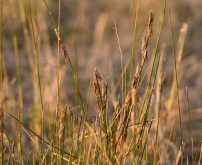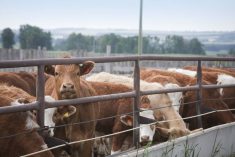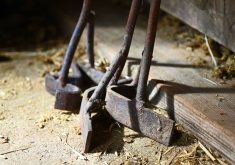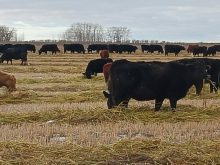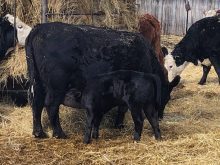Don and Diane Guilford have been practicing holistic management on their 1,200-acre ranch near Clearwater, Man. since the early 1980s.
Don is the third generation of his family in that region and says holistic management has made a big difference in his success as a farmer. He took his first course with Allan Savory at Bismarck, N.D.
“That was a life-changing event. I came back to the ranch and tried to do some of the things he talked about, but it was very intense — five and a half days of lecturing — and you don’t retain 100 per cent.”
Read Also

Harvest wraps up and fall work begins
At the Eppich famly ranch in western Saskatchewan, the fall harvest was successful with few breakdowns, cows and calves have been sorted and a new tractor has arrived
Since then, Don has taken two more courses and has helped Ralph Corcoran (a certified educator from Saskatchewan) present a course.
“The last course I took was in our local area, to meet with like-minded people who understood what I was doing and have someone to bounce ideas off and get feedback,” Don says. “We formed a club, and for about 15 years met once a month.”
His parents were supportive of what he was trying to do, even though they didn’t always understand it. After his father passed away, his mother said he’d told her, “I don’t have a clue what he’s doing, but he seems to be making headway.”
Change can be hard if a person has always done things a certain way, but holistic management enabled Don to improve his pastures and run more cattle. He was one of the first ranchers in his area to start bale grazing and winter cows out on pasture.
“I worried that somebody would report me for cruelty to animals because they didn’t know what I was doing, but now some of the guys in our neighbourhood who probably thought I was off my rocker back then are feeding their cows out on the land and achieving some of the same goals.”
Boosting yield
The Guilfords’ approach allows them to put nutrients back on the land and improve the soil. Don puts bales very close together on a piece of ground he wants to improve, so it gets covered with litter and manure. The bales are only 25 to 30 feet apart, which gives an even covering. On one piece he had 750 bales on 15 acres, completely covering it.
Rejean Picard, from Manitoba Agriculture, did soil sampling at the site before and after the bales were put there.
“One year later, we’d increased our yield on that field by 10-fold. Plus, we haul hay straight from the hayfield in July — to where we plan to bale graze — so we only handle the hay once.”
This practice reduces the cost of harvest and winter feeding. Don and his wife could move electric fences and feed 200 cows in 20 minutes, for one week.
READ MORE: Lessons in cow economics learned in the field
“We experimented on how often to let the cattle into a new batch of bales. We tried three days, a week, two weeks, and a month,” Don says. “Even letting them have an area for a month, from what the cows would normally eat in a bale feeder in the corral, we wasted the equivalent of only one or two bales and didn’t use any diesel fuel for feeding.”
The approach has saved money and created more productive ground. In doing so, they have increased the number of cows per quarter.
“Ten more cows is a 33 per cent increase in number, plus adding the length of grazing has given us about twice the amount of grazing, on the same land. This makes the land more profitable. If I wasn’t doing this, I’d be looking for more land or spending money for more hay.”
Importance of budgeting
Don and Diane have continued with holistic management, not only because it has improved their land but also because this method of record-keeping enables them to know if they are making headway or going backward.
The cattle business, of course, isn’t easy. Many Canadian ranchers faced a tough time getting through the BSE crisis. “Bankers were watching us carefully. We’d done our holistic budgets and plans for the year, and the bank was making life difficult for us,” Don recalls. “At that time we had 300 cows and in 2003 the market was so terrible (due to BSE) that we kept all our heifers.”
The next two years were no better, so they kept them all again, and got to the point where they bred 605 cows.
“We were stretching our pasture resources and buying hay,” Don says.
“At that point we quit the Royal Bank and went to the credit union to see if they were interested in doing our loan. They had us fill out a line of credit and I asked if they wanted to see our bookkeeping.”
Don showed them the ranch’s numbers, including operating needs for each month of the year — something the credit manager said they were the first to do. The lender wanted clients who knew their operation well enough to predict what they were going to make and what it would cost. Holistic management can help guide people through the tough times, and in the good times create a higher level of profit.
This budgeting gave Don more confidence. “You think you can make it, but you aren’t sure. Once you do a budget you know you can make it. You might not make much profit, but you know you are in the black. When I got a semi-load of feed that cost 10 grand, I was comfortable writing the cheque because I knew I could pay for it,” he says.
“Holistic management has made a huge difference in our lives, helping us get through BSE and other challenges. After a 15-year grind we came out on the other side with more cows than we went into it. I told my banker the only way we both would come out ahead was if I had inventory when prices recover. We lived on a tight budget, but doubled our cow herd during BSE when many people were selling cows at low prices. When prices came back, we sold cows for $2,700 that the bank valued at $800.”

Many people sold cows to try to retain the same amount of gross income and got farther behind, but Don and Diane were keeping replacements, doubling their stocking rates with bale grazing, and making progress. In 2006, though, they decided they had to sell some cows.
“We were running out of pasture, and dry-lotted 100 cows on 50 acres all summer,” Don says. “It was hard on the land, but the cows did well; we fed raw screenings and straw along with the pasture… We sold those cows in Swift Current, and they did well, on very cheap feed.”
Looking ahead
The long-term effect of holistic management has greatly improved the farm. The 1,200 acres will easily handle 250 cows and 50 replacement heifers, and still have hay ground. “This is our goal if our grandson comes back to ranch,” Don says.
A person spends a lifetime building a place and good cattle and hopes family will carry on, he says. “You have to enjoy it, however. We would never have made it through BSE if we didn’t like what we were doing. At my age (74), people ask why I don’t quit, and I tell them I like what I’m doing and it gives me a reason to get up in the morning.
“If our grandson comes back, Diane and I can keep doing it longer.”
Their grandson is currently working toward a diploma in agriculture and hopes to come back full-time.
“I’d like for him and me and Diane, and maybe his mother, to take a week-long course in holistic management. The value in that is we all sit down together and set personal goals and ranch goals — what we want to be and do — along with financial plans. It’s important to all be on the same page in terms of our expectations.”




